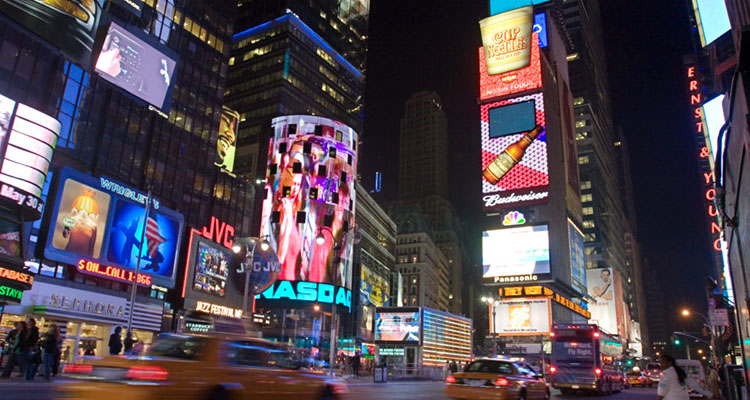Digital Signage Trends To Watch In 2017
By Lee Gannon
TrouDigital
Digital signage has been around for a few years now. It was originally the reserve of large corporations with deep marketing budgets and most popular in consumer-facing industries like retail.
Today, digital signage is increasingly sophisticated (as well as more affordable) and its users are highly creative in its application. It can be found in almost any sector, with the education market in particular exploding as screens multiply around campuses and colleges. In this article, we review industry trends as we enter 2017 and make predictions for the future of digital signage.
 Gamification
Gamification
Gamification has been one of the biggest developments in not only the technology world but in marketing over the past decade. Nike+ pioneered this trend back in 2006, transforming running into a game with a vast community of competing players. Gamification creates an immersive experience for consumers, encouraging engagement with a brand or product.
The interactivity of digital signage and gamification has been a perfect match. In retail, for example, screens are often used to deploy brand or product related games. The use of in-game leaderboards has become particularly popular. The most effective retailers might offer daily prizes in the form of shop vouchers to their best performing players.
Gamification is equally popular when it comes to digital signage in education. Classroom games allow students to learn or be tested on material without it feeling too much like school. The class test has effectively been replaced with the interactive quiz.
Near Field Communication
Near field communication (or NFC) has been another milestone in interactive technology, and one ideally suited to digital signage as a platform. Major cities like London are already familiar with a ‘tap culture’ that includes Oyster cards and Apple Pay. With NFC integrated digital signage, consumers can tap digital displays with their smart-phones to engage with its content.
The sector where this seems to really come into its own is real estate. Without having to go inside an agency for a brochure, prospects can collect property information on their phones by tapping digital property listings in the window to save them for later. NFC in digital signage is definitely a technology to watch as concepts like Apple Pay become mainstream.

Big Data Analytics
Marketing today is driven by big data. Companies want to know where and exactly who they are spending their budgets on. Everything is recorded. Once anonymous visitors to your website are now tracked and characterized, with companies knowing the demographic and source of their leads through tools like Google Analytics.
The problem with traditional forms of advertising like TV or radio is that marketers have a very limited understanding of their reach. It’s not enough to know how many viewers tuned into Coronation Street at a certain time. Broadcasters have no way of knowing how many left to put the kettle on while your advert was playing, or how many viewers fast-forwarded it on demand altogether.
As a marketing channel that breaches offline and online, digital signage is uniquely positioned to cater for the drive towards big data. Up until now, retailers, for example, had no real means of collecting data for engagement with their billboards etc.
Developments in digital signage technology now mean that screens are able to track who’s walking past and who’s stopping to engage with their content. Almost every mobile phone nowadays has Bluetooth. Using this, advanced signage screens are able to collect data on passers-by. Some screens even have eye-tracking and facial-recognition capacity. At the forefront of the technology, retail digital signage is able to identify the gender and age of its real-time audience and adapt its content accordingly. This kind of targeted marketing is surely the future of display advertising.
Profit Generating Potential
Finally, we want to talk about digital signage as a financial investment. The first trend to acknowledge is the dramatic fall in hardware costs. Everyone today knows you can pick up a TV screen far superior in quality and at a fraction of the price of a screen just a few years ago. As screens have always been the largest cost associated with digital signage, this is great news for the end-user. Similarly, media players have continued to get smaller while growing more powerful and affordable.
The trend that is yet to be properly exploited, however, is the profit-generating potential of digital signage. Advertisers trade in attention. Today people are glued to screens so the premium on this space is rocketing. The more screens a user has on their network, and the higher footfall their locations, the greater the value of this platform to potential sponsors. A dynamic digital signage solution allows users to intersperse internal and external forms of content. 30 seconds out of a two-minute loop, for example, might be sold to advertisers.
The benefit of owning a network of screens is having complete control over the extent and nature of your advertising. Working with sponsors does not have to mean selling out. A dentist, for instance, might want to only display sponsored content for dental products they genuinely recommend. If you own a chain of stores or practices, or just a large network of screens on one vast site, sponsors will be biting your hand off to gain access to your audience.
What we are beginning to see are companies across sectors, even charities, investing in digital signage primarily to generate profit, with the internal communication capacity of the technology being a welcome side feature. It is not unusual for large companies to happily spend £2,500 a month on a 100 screen nation-wide network, in the knowledge they can sign up a dozen sponsors at £1,000 a month each for a slot in their content playlist.
Conclusion
As we enter 2017, digital signage is becoming an increasingly powerful communication platform, one that is able to reinvent itself and adapt to a number of applications and sectors. Gamification and near field communication are great examples of its capacity to integrate with developments across technological fronts. The future of digital signage is exciting precisely because of this versatility. The trend to definitely watch is this drive towards big data. Screens that are able to measure engagement, whether it’s through Bluetooth, facial recognition, eye-tracking or some future breakthrough, will have unprecedented value to marketers. The days of wondering how many people actually saw the posters you had printed, or heard the radio advert you had produced, are almost over. The introduction of audience metrics to digital signage will consolidate its place as a high priority for communicators and advertisers alike.





